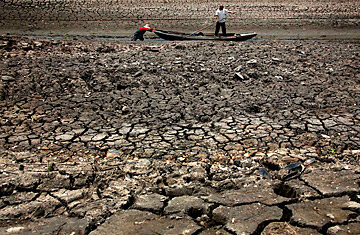
David Gray / Reuters
In China food supplies and food prices are deeply sensitive topics. So by the time the U.N.’s Food and Agriculture Organization issued a special alert warning in February that a prolonged drought in the North China Plain was a “potentially serious problem” for the country’s winter wheat crop, China’s leaders had already mobilized. President Hu Jintao and Premier Wen Jiabao made visits to farming regions in north China, pledging cash, equipment and manpower to ensure the crop survived.
That wheat is now being harvested, and it seems the danger has been averted. This week China’s agriculture minister Han Changfu predicted a bumper harvest, saying that a long-term increase in the production base as well as irrigation efforts aided wheat output. But even as Han stood in Henan wheat field celebrating a problem successfully averted, other worries were emerging.
For an indication of the problem, take a look at the map below, which was issued by China’s Ministry of Water Resources on June 2:
Parts of central China, including the middle and lower reaches of the Yangtze River, are experiencing the lowest levels of rainfall in 50 years. The area in red is affected by serious drought, and the brown indicates extreme drought. The parched areas also happen to include much of China’s main rice producing regions, which are in the early stages of their growing season. So for the second time in a year, a major grain crop in China is now at risk due to a shortage of water. So far no warnings of the seriousness of the FAO’s February declaration on winter wheat have been issued. But anecdotal reports indicate some worries. A story by the state-run Xinhua news service late last month said that rice farmers in Hunan and Hubei provinces, two major rice growing areas, anticipated lower yields because of the drought. At the same time, the acreage of planted rice may climb thanks to higher prices, the Ministry of Agriculture said recently. That may help avoid too sharp a drop in overall output.
Prices of some agricultural products heavily dependent on abundant water supplies have shot up recently, particularly cabbage, celery and bok choy, but the state press has emphasized that grain prices shouldn’t jump due to the drought. Although China has grown to an economic colossus in recent decades, its deadly famines of the 20th century aren’t forgotten. The Chinese government has put a high political importance on self-sufficiency in grains, and the country has largely managed to achieve that. China has built up a large strategic grain reserve, which can be tapped to ensure a steady supply and keep price rises in check. Statements by government officials in recent years indicate that China has grain reserves equivalent to 30-40% of annual production, although those figures are somewhat suspect as there have been cases of granaries overstating their reserves to boost revenues from the government. Even so, China’s reserves are thought to be far above the minimum 17-18% reserve levels the FAO says are necessary for global food security.
“The first message is because of China’s stocks, there’s no real reason to panic this year,” says Robert S. Zeigler, director general of the Philippines-based International Rice Research Institute. “The second message is that they will be okay for this year, but what happens next year? If you draw down stocks this year, you become quite vulnerable next year.” And that is perhaps the biggest worry about drought in China. The government has shown it will do whatever necessary to ensure healthy grain supply, and tap foreign suppliers to make up any shortfalls. But as food prices rise globally, the knock-on effect of any shortfall here will inevitably be felt elsewhere. “There are number way that this plays out,” says Zeigler. “Assuming a significant drop in production, China could opt to only draw down part of its reserves and seek make up rest on world markets. The world rice market is very thin, and that could quickly rattle the market just given size of China.”


